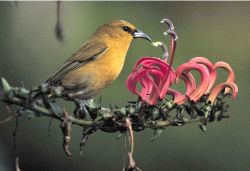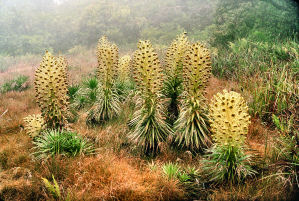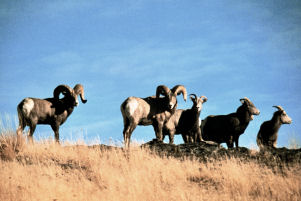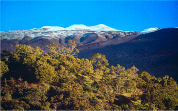
This page last revised 11 July 2007 -- S.M.Gon III
Introduction
Ecoregion
Conservation Targets
Viability
Goals
Portfolio
TNC Action Sites
Threats
Strategies
Acknowledgements
▫
Tables
Maps & Figures
CPT Database
Appendices
Glossary
Sources


Rare plant species such as bog greenswords, may constitute a conservation target.

Feral ungulates are alien mammals that constitute a critical threat to Hawaiian ecological systems.

The snow-capped alpine ecological system is one of the conservation targets of the Hawaiian High Islands ecoregion.
Glossary
Terms that are used in this ecoregional plan are briefly defined here.acceptable range of variation–limits of variation allowing persistence of the target(persistence may still require human management intervention).This acceptable range of variation is theminimum criteria for identifying a target as“conserved.”
alien - non-native, introduced by human beings; also: exotic, adventive, non-indigenous.
biogeoclimatic - biological, geological, and prevailing climatic conditions, combined to characterize a region.
biogeography - the study of the patterns and process determining the global distribution of biota.
biota - living elements, from species to ecological systems.
CAP Excel Workbook– An Excel-based software program developed by The NatureConservancy to facilitate the Conservation Action Planning (CAP) process, automate the roll-up ofsummary results, and serve as a consistent repository for CAPinformation. Download from: http://www.conserveonline.org/2003/07/s/ConPrjMgmt_v4.
condition - one the three factors considered in viability assessment; anintegrated measure of biotic and abiotic factors, structures, andprocesses related to the "health" or viability of a conservationtarget, e.g., reproduction, levels of competition/predation/disease,population structure. For natural communities and ecological systems,condition relates to structure and biotic composition, and typicalecological processes. see also, size, landscape context, viability
Conservation Action Planning (CAP)– The Nature Conservancy’s process for helping conservationpractitioners develop strategies, take action, measure success, andadapt and learn over time. See: http://conserveonline.org/workspaces/cap/TNC_CAP_Basic_Practices_v_17_Jun_05.pdf
conservation area/site –In Ecoregional planning, synonymous with the more appropriate term“area of biodiversity significance”. In Conservation areaplanning, equivalent to “project area”. AlthoughEcoregional plans may delineate rough or preliminary site boundaries oruse other systematic units such as watersheds or hexagons as siteselection units, the boundaries and the target occurrences containedwithin these areas are first approximations that will be dealt with inmore specificity and accuracy in the CAP process.
conservation target - an element of biological diversity identified for protective action; often a surrogate for regional diversity.
conservation value -an index for a conservation area (see above) that assesses threefactors: biodiversity (at species, natural community andecological system levels), viability (see below), and complementarity(contribution of an area to the overall biodiversity of the ecoregion,closely linked to area endemism). Conservation value is an integralpart of action site ranking.
critical threat – sources of stress that are most problematic. Most often, “veryhigh” and “high” rated threats based on theConservancy’s rating criteria of the scope, severity,contribution, and reversibility of their impact on targets
current status – anassessment of the current “health” of a target as expressedthrough the most recent measurement or rating of an indicator for a keyecological attribute. Compare to desired status.
desired status – ameasurement or rating of an indicator for a key ecological attributethat describes the level of viability/integrity that the projectintends to achieve. Compare to current status.
disharmonic - a term in biogeography referring to taxonomic units (e.g., genera, families) conspicuously absent from an ecoregion due to isolation.
ecological system - suites of ecologically linked natural communities sharing similar biogeoclimatic conditions.
ecoregion- a large unit of land or water containing ageographically distinct assemblage of species, natural communities, andenvironmental conditions.
ecoregional assessment– the Nature Conservancy’s process for setting prioritiesfor conservation in ecoregions. same as “ecoregional plan”.
ecoregional goals – the number and spatial distribution of conservation targets (species, communities, and ecological systems) neededto adequately conserve the targets in an ecoregion. also called“conservation goal.”
ecosystem integrity - see integrity
ecoregional plan – see ecoregional essessment
ecoregional portfolio - the suite of conservation sites that will collectively conserve the biodiversity of an ecoregion.
effective conservation - acombination of permanent protective designation, andactive management to abate threats and maintain or increase theviability of conservation targets and biodiversity in an area. Thegoal of The Nature Conservancy globally is to bring effectiveconservation to at least 10% of the world's major habitat types.
element - shorthand for"element of biological diversity" referring to the basic buildingblocks of diversity: plants, animals, and natural communities.
endemic - restricted biogeographically to a place.
focal conservation target– target in Conservation Area Planning; a limited suite(≤8) of species, communities, and ecological systems chosento represent and encompass the full array of biodiversity in aproject area. One focal conservation target may reflectthe needs of many other targets in a conservation area or ecoregion.
goal - see ecoregional goal.
Holdridge life forms -categories of ecological settings (temperature, moisture, elevation,latitude), established for global biogeographic description andcomparison by L.R. Holdridge (1947).
indigenous - native to a place; found naturally there, but necessarily restricted to a place.
integrity – status or “health” of an ecological community or system; ability of a community or system target towithstand or recover from natural or anthropogenic disturbances. Seealso viability for species.
key ecological attributes -- aspects of a target’sbiology or ecology that are critical to persistence of that target over time; i.e., that determine the target’sviability or integrity. These are typically the most critical componentsof biological composition, structure, interactions and processes,environmental regimes, and landscape configuration that sustain atarget’s viability or integrity.
landscape context - one the three factors considered in viability assessment; spatialaspects of connectivity or access to other populations, species andecological processes in the surrounding habitat or landscape. see alsosize, condition, viability.
natural community - aconsistent and distinctive set of ecologically interacting plants andanimals that occur together via shared habitat requirements.
portfolio of sites - see ecoregional portfolio
size - one the threefactors considered in viability assessment; a measure of area orabundance of a conservation target occurrence (size of a speciesoccurrence may include area of occupation or population counts, whilesize of a natural community or ecological system is typically couchedin area of extent)
sources of stress – proximate agents or factors that directly degrade targets; direct threats.
stakeholders – individuals, groups, or institutions with avested interest in the natural resources of an area, and/or whopotentially will be affected by conservation activities.
strategic actions – interventions designed toreach strategic objectives. see strategy
strategy – broadcourse of action defined by having one or more objectives, strategic actionsrequired to accomplish objectives, and specific steps required tocomplete those actions.
stratification unit - one of several broad geographical subdivisions established across an ecoregion to ensure representation of biodiversity.
stress – disturbance likely to destroy or degrade a conservation target directly or indirectly.
target - see conservation target.
threat – agent or factor that directly or indirectly degrades a conservation target. see sources of stress.
viability – status or “health” of a species population; ability of aconservation target to withstand or recover from natural oranthropogenic disturbances and persist for long time periods. See also integrity for natural communitiesand ecological systems. Three factors are examined when characterizing viability: size, condition, and landscape context.
watershed- an area of water input and flow, typically upland and defined bystream drainages from high precipitation areas, often, but not alwaysforested. In Hawai‘i, watersheds typically correspond to native wetforest ecosystems.
watershed partnership- a voluntary alliance of public and private landowners and managersworking together to protect a defined upland forest area for itsecological and water resource values. (see watershed).